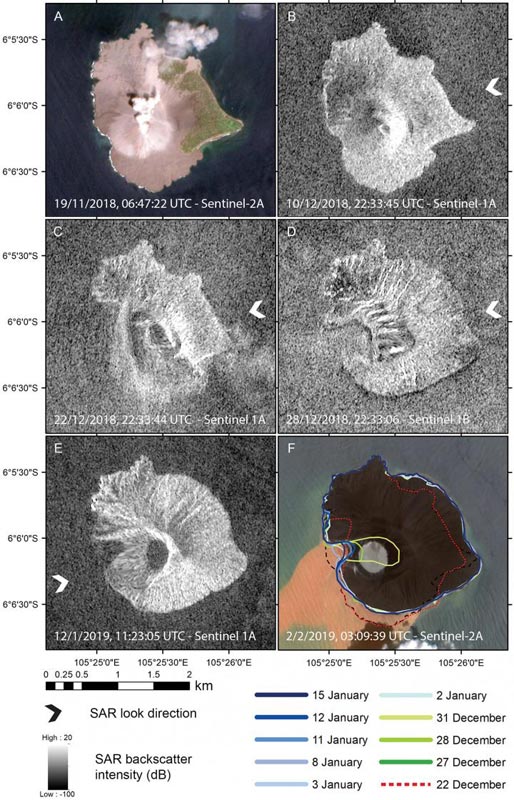Reconstructing Anak Krakatau flank collapse that caused Dec. 2018 Indonesian tsunami

Satellite imagery showing the evolving geomorphology of Anak Krakatau (Indonesia) as a result of the December 2018 through January 2019 eruptive activity and the 22 December 2018 tsunami. (A, B) Island morphology before the flank failure. Image in panel C was captured only 8 hours after the tsunami, and shows the western flank failure and collapse of the summit. (D) The destruction of the summit. (E) The subsequent regrowth of the island. (F) Changes in island surface area through this period. A and F are European Space Agency satellite Sentinel-2A true-color images, and panels B-E are Sentinel-1A and Sentinel-1B SAR backscatter images. Arrows show the radar look direction. Credit: Williams et al., Geology
A new study published in Geology presents the detailed observation of a tsunami-generating volcano collapse by remote sensing. The paper by Rebecca Williams of the University of Hull and colleagues analyzes the 2018 collapse of Anak Krakatau, which triggered a tsunami that claimed over 430 lives and devastated coastal communities along the Sunda Strait, Indonesia.
This collapse was captured in unprecedented detail by satellite remote sensing, providing an opportunity to understand the collapse of the volcano in a way that has not previously been possible at any volcanic island in the world.
The teams' analysis shows that the catastrophic tsunami was actually caused by a relatively small landslide–an observation with important implications for communities affected by volcanoes and those responsible for assessing their hazard.
Using a suite of observational data, Williams and colleagues' paper reconstructs the eruptive activity of Anak Krakatau before, during, and after the flank collapse.
They find that the volcano was in a normal eruptive state before the flank collapse, but that the collapse changed the style of the continuing eruption, resulting in a reconfiguration of the magmatic plumbing system of the volcano, which allowed water to enter the system. This in turn caused the eruption to switch to a much more explosive, phreatomagmatic, style. This subsequent activity caused the actual destruction of the volcano's summit and the destructive remodeling of the landscape that can be observed in more recent satellite images.
“It is important to not overestimate the tsunami-generating flank collapse volume by not recognizing the volcanic eruption as the main cause of the dramatic geomorphological changes seen in late December when good true colour satellite images were first available, rather than the synthetic-aperture radar (SAR) image we use immediately after the event,” says Williams.
Williams and colleagues conclude that the 2018 Sunda Strait tsunami was generated by an unexceptional eruption, which is an unexpected result.
Small flank failures causing large tsunamis represent a vastly underappreciated geohazards–current tsunami monitoring systems do not monitor for this kind of volcanic activity, instead focusing on large earthquakes or proxies related to unusual increases in magma intrusion. This paper demonstrates the rapid first analyses that can be done with remote sensing to inform hazard analyses and risk mitigating strategies in the short-term with low-latency free satellite remote sensing observations and no fieldwork.
###
FEATURED ARTICLE
Reconstructing the Anak Krakatau flank collapse that caused the December 2018 Indonesian tsunami
Rebecca Williams et al., Rebecca.Williams@hull.ac.uk. URL: https:/
GEOLOGY articles are online at http://geology.
Image caption: Satellite imagery showing the evolving geomorphology of Anak Krakatau (Indonesia) as a result of the December 2018 through January 2019 eruptive activity and the 22 December 2018 tsunami. (A, B) Island morphology before the flank failure. Image in panel C was captured only 8 hours after the tsunami, and shows the western flank failure and collapse of the summit. (D) The destruction of the summit. (E) The subsequent regrowth of the island. (F) Changes in island surface area through this period. A and F are European Space Agency satellite Sentinel-2A true-color images, and panels B-E are Sentinel-1A and Sentinel-1B SAR backscatter images. Arrows show the radar look direction.
Media Contact
More Information:
http://www.geosociety.org/GSA/News/pr/2019/19-28.aspxAll latest news from the category: Earth Sciences
Earth Sciences (also referred to as Geosciences), which deals with basic issues surrounding our planet, plays a vital role in the area of energy and raw materials supply.
Earth Sciences comprises subjects such as geology, geography, geological informatics, paleontology, mineralogy, petrography, crystallography, geophysics, geodesy, glaciology, cartography, photogrammetry, meteorology and seismology, early-warning systems, earthquake research and polar research.
Newest articles

Nerve cells of blind mice retain their visual function
Nerve cells in the retina were analysed at TU Wien (Vienna) using microelectrodes. They show astonishingly stable behavior – good news for retina implants. The retina is often referred to…

State-wide center for quantum science
Karlsruhe Institute of Technology joins IQST as a new partner. The mission of IQST is to further our understanding of nature and develop innovative technologies based on quantum science by…

Newly designed nanomaterial shows promise as antimicrobial agent
Rice scientists develop nanocrystals that kill bacteria under visible light. Newly developed halide perovskite nanocrystals (HPNCs) show potential as antimicrobial agents that are stable, effective and easy to produce. After…



